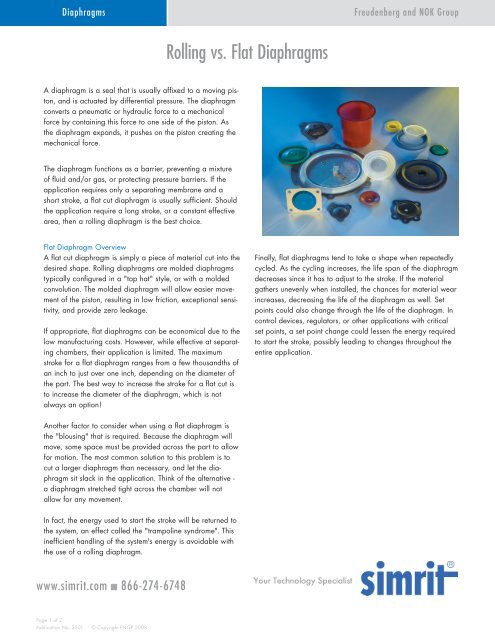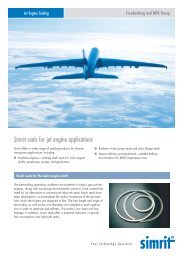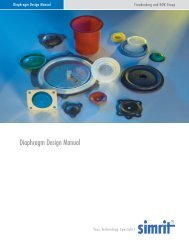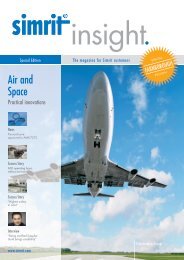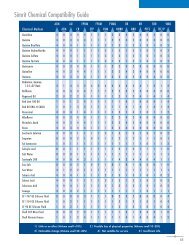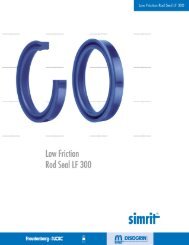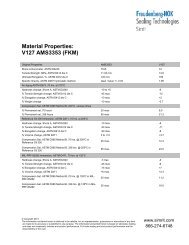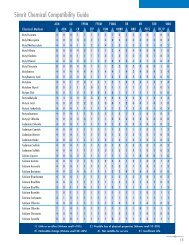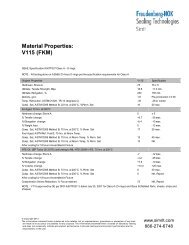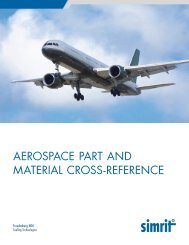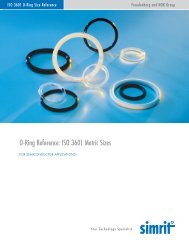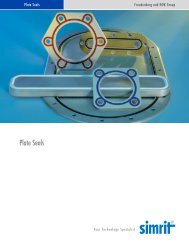Rolling vs. Flat Diaphragms - Simrit
Rolling vs. Flat Diaphragms - Simrit
Rolling vs. Flat Diaphragms - Simrit
- No tags were found...
Create successful ePaper yourself
Turn your PDF publications into a flip-book with our unique Google optimized e-Paper software.
<strong>Diaphragms</strong>Freudenberg and NOK Group<strong>Rolling</strong> <strong>vs</strong>. <strong>Flat</strong> <strong>Diaphragms</strong>A diaphragm is a seal that is usually affixed to a moving piston,and is actuated by differential pressure. The diaphragmconverts a pneumatic or hydraulic force to a mechanicalforce by containing this force to one side of the piston. Asthe diaphragm expands, it pushes on the piston creating themechanical force.The diaphragm functions as a barrier, preventing a mixtureof fluid and/or gas, or protecting pressure barriers. If theapplication requires only a separating membrane and ashort stroke, a flat cut diaphragm is usually sufficient. Shouldthe application require a long stroke, or a constant effectivearea, then a rolling diaphragm is the best choice.<strong>Flat</strong> Diaphragm OverviewA flat cut diaphragm is simply a piece of material cut into thedesired shape. <strong>Rolling</strong> diaphragms are molded diaphragmstypically configured in a "top hat" style, or with a moldedconvolution. The molded diaphragm will allow easier movementof the piston, resulting in low friction, exceptional sensitivity,and provide zero leakage.If appropriate, flat diaphragms can be economical due to thelow manufacturing costs. However, while effective at separatingchambers, their application is limited. The maximumstroke for a flat diaphragm ranges from a few thousandths ofan inch to just over one inch, depending on the diameter ofthe part. The best way to increase the stroke for a flat cut isto increase the diameter of the diaphragm, which is notalways an option!Finally, flat diaphragms tend to take a shape when repeatedlycycled. As the cycling increases, the life span of the diaphragmdecreases since it has to adjust to the stroke. If the materialgathers unevenly when installed, the chances for material wearincreases, decreasing the life of the diaphragm as well. Setpoints could also change through the life of the diaphragm. Incontrol devices, regulators, or other applications with criticalset points, a set point change could lessen the energy requiredto start the stroke, possibly leading to changes throughout theentire application.Another factor to consider when using a flat diaphragm isthe "blousing" that is required. Because the diaphragm willmove, some space must be provided across the part to allowfor motion. The most common solution to this problem is tocut a larger diaphragm than necessary, and let the diaphragmsit slack in the application. Think of the alternative -a diaphragm stretched tight across the chamber will notallow for any movement.In fact, the energy used to start the stroke will be returned tothe system, an effect called the "trampoline syndrome". Thisinefficient handling of the system's energy is avoidable withthe use of a rolling diaphragm.www.simrit.com 866-274-6748Page 1 of 2Publication No. 3501 © Copyright FNGP 2008
<strong>Diaphragms</strong>Freudenberg and NOK Group<strong>Rolling</strong> Diaphragm Overview<strong>Rolling</strong> diaphragms avoid this problem by factoring in therequired stroke of the diaphragm in the hardware. A convolutionmolded into the diaphragm, designed to move in conjunctionwith the piston, uses less energy to start the stroke,and provides a constant effective pressure area. This guaranteesa repeatable displacement each and every time.Molded diaphragms provide stable set points, low hysteresis,and longer life. Since the molded diaphragm is designed tomeet the specific stroke requirements, the resistance to movementis significantly less than the flat diaphragm, resulting in amore efficient system. Additionally, because the diaphragm hasalready taken the shape of the stroke, the material suffers lesswear.Besides technical advantages, molded diaphragms can alsooffer assembly advantages too. Since flat diaphragms almostalways require some blousing, time must be taken at assemblyto incorporate the diaphragm into the application. A moldedconvoluted diaphragm can be placed into the assembly withoutany additional work. In most cases, a molded diaphragm offerslower total cost when considering assembly, and life.Summary<strong>Flat</strong> diaphragms can be an effective seal in limited applications.However, based on the application requirements, amolded diaphragm is a cost effective sealing solution thatwill provide significant advantages over a flat diaphragm.The result will be longer life, a constant effective pressurearea, low friction, repeatability and sensitivity in a broadpressure range.www.simrit.com 866-274-6748Page 2 of 2Publication No. 3501 © Copyright FNGP 2008


